Optimal Scale and Scenario Simulation Analysis of Landscape Ecological Risk Assessment in the Shiyang River Basin
Abstract
:1. Introduction
2. Materials and Methods
2.1. Study Area
2.2. Data Sources and Pre-Processing
2.3. Methods
2.3.1. Optimal Scale Analysis Methods
- (1)
- Granularity effect analysis
- (2)
- The semivariogram function
2.3.2. LER Analysis Methods
- (1)
- LER assessment model
- (2)
- Spatial autocorrelation analysis
2.3.3. Multi-Scenario Simulation of Future LER
- (1)
- PLUS model and validation
- (2)
- Scenario setting
3. Results
3.1. Optimal Scale Analysis
3.1.1. Optimal Particle Size Analysis
3.1.2. Optimal Margin Analysis
3.2. LER Analysis in Shiyang River Basin
3.2.1. Spatial and Temporal Distribution and Change of LER
3.2.2. Spatial Correlation Analysis of LER
3.3. Multi-Scenario Simulation of LER in Shiyang River Basin
3.3.1. Changes in Land Use Types under Different Scenarios
3.3.2. Characteristics of LER Changes under Different Scenarios
4. Discussion
5. Conclusions
Supplementary Materials
Author Contributions
Funding
Institutional Review Board Statement
Informed Consent Statement
Data Availability Statement
Conflicts of Interest
References
- Vitousek, P.M.; Mooney, H.A.; Lubchenco, J.; Melillo, J.M. Human domination of earth’s ecosystems. Science 1997, 277, 494–499. [Google Scholar] [CrossRef]
- Ghosh, S.; Chatterjee, N.D.; Dinda, S. Urban ecological security assessment and forecasting using integrated DEMATEL-ANP and CA-Markov models: A case study on Kolkata Metropolitan Area, India. Sustain. Cities Soc. 2021, 68, 102773. [Google Scholar] [CrossRef]
- Zhu, C.; Jiang, F.; Wu, L.; Zeng, M.; Jia, T.; Zhou, S.; Ning, Y.; Yu, J.; Feng, X. On the problems of urbanization in the Yangtze River Delta under the background of global change. Acta Geogr. Sin. 2017, 72, 633–645. [Google Scholar]
- Wang, J.; Zhou, W.; Pickett, S.T.A.; Yu, W.; Li, W. A multiscale analysis of urbanization effects on ecosystem services supply in an urban megaregion. Sci. Total Environ. 2019, 662, 824–833. [Google Scholar] [CrossRef] [PubMed]
- Peng, J.; Dang, W.X.; Liu, Y.X.; Zong, M.; Hu, X. Review on landscape ecological risk assessment. Acta Geogr. Sin. 2015, 70, 664–677. [Google Scholar]
- Landis, W.G. Twenty years before and hence; ecological risk assessment at multiple scales with multiple stressors and multiple endpoints. Hum. Ecol. Risk Assess. 2003, 9, 1317–1326. [Google Scholar] [CrossRef]
- Chen, S.Q.; Chen, B.; Fath, B.D. Ecological risk assessment on the system scale: A review of state of the art models and future perspectives. Ecol. Model. 2013, 250, 25–33. [Google Scholar] [CrossRef]
- Xing, L.; Hu, M.S.; Wang, Y. Integrating ecosystem services value and uncertainty into regional ecological risk assessment: A case study of Hubei Province, Central China. Sci. Total Environ. 2020, 740, 140126. [Google Scholar] [CrossRef]
- Landis, W.G.; Wiegers, J.A. Perspective: Design considerations and a suggested approach for regional and comparative ecological risk assessment. Hum. Ecol. Risk Assess. 1997, 3, 287–297. [Google Scholar] [CrossRef]
- Fu, B.J.; Liang, D.; Lu, N. Landscape ecology: Coupling of pattern, process, and scale. Chin. Geogr. Sci. 2011, 21, 385–391. [Google Scholar] [CrossRef]
- Su, C.H.; Fu, B.J. Discussion on Links Among Landscape Pattern, Ecological Process, and Ecosystem Services. Chin. J. Nat. 2012, 34, 277–283. [Google Scholar]
- Chen, J.P.; Zhang, Y.; Yu, Y.J. Effect of MAUP in Spatial Autocorrelation. Acta Geogr. Sin. 2011, 66, 1597–1606. [Google Scholar]
- Wu, J. Effects of changing scale on landscape pattern analysis: Scaling relations. Landsc. Ecol. 2004, 19, 125–138. [Google Scholar] [CrossRef]
- Ju, H.; Niu, C.; Zhang, S.; Jiang, W.; Zhang, Z.; Zhang, X.; Yang, Z.; Cui, Y. Spatiotemporal patterns and modifiable areal unit problems of the landscape ecological risk in coastal areas: A case study of the Shandong Peninsula, China. J. Clean. Prod. 2021, 310, 127522. [Google Scholar] [CrossRef]
- Peng, J.; Zong, M.; Hu, Y.; Liu, Y.; Wu, J. Assessing Landscape Ecological Risk in a Mining City: A Case Study in Liaoyuan City, China. Sustainability 2015, 7, 8312–8334. [Google Scholar] [CrossRef]
- Zheng, K.J.; Li, C.; Wu, Y.M.; Gao, B.P.; Li, C.; Wu, Y. Temporal and spatial variation of landscape ecological risk and influential factors in Yunnan border mountainous area. Acta Ecol. Sin. 2022, 42, 7458–7469. [Google Scholar]
- Liu, K.X.; Wang, D.M.; Wei, Y.S.; Chang, G.L. Spatio-temporal evolution trend of multi-scale landscape ecological risk in Miyun Reservoir watershed. Acta Ecol. Sin. 2023, 43, 105–117. [Google Scholar]
- Gao, C.; Zhao, J.; Li, C.H.; Wei, W.; Wang, J.B.; Kang, C.Y. Grassland cover and ecological service function changes in Shiyang River basin. Pratacultural Sci. 2019, 36, 27–36. [Google Scholar]
- Zhong, K.W.; Li, J.L.; Zhang, X.D. Application of hybrid programming of vc and matlab in road extration from remote sensingimage. J. Geomat. 2007, 32, 10–12. [Google Scholar]
- Zhao, J.; Yang, D.H.; Pan, J.H. A study on spatial pattern of GDP in Lanzhou City based on spatialization and land utilization. J. Northwest Norm. Univ. 2010, 46, 92–96+102. [Google Scholar]
- Zhao, W.U.; Fu, B.J.; Chen, L.D. The effects of grain change on landscape indices. Quat. Sci. 2003, 23, 326–333. [Google Scholar]
- Zhang, L.L.; Zhao, Y.H.; Yin, S.; Fang, S.; Liu, X.J.; Pu, M.M. Gradient analysis of dry valley of Minjiang River landscape pattern, based on moving window method. Acta Ecol. Sin. 2014, 34, 3276–3284. [Google Scholar]
- Zuo, Q.; Zhou, Y.; Li, Q.; Wang, L.; Liu, J.Y.; He, N. Spatial and temporal variations of landscape ecological risk in the mountainous region of southwestern Hubei Province based on optimal scale. Chin. J. Ecol. 2023, 42, 1186–1196. [Google Scholar]
- Xu, Z.Y.; Hu, Y.F.; Liu, Y.; Yan, Y. A Review on the Accuracy Analysis of Spatial Scaling Data. Prog. Geogr. 2012, 31, 1574–1582. [Google Scholar]
- Li, Y.; Wen, F.G.; Yong, F.D.; Ze, X.L. Study on Ecological Risk of Land Use in Urbanization Watershed Based on RS and GIS: A Case Study of Songhua River Watershed in Harbin Section. Asian Agric. Res. 2013, 5, 61–65+69. [Google Scholar]
- Li, S.; Wang, L.; Zhao, S.; Gui, F.; Le, Q. Landscape Ecological Risk Assessment of Zhoushan Island Based on LULC Change. Sustainability 2023, 15, 9507. [Google Scholar] [CrossRef]
- Yu, H.; Liu, X.L.; Zhao, T.; Zhang, M.; Nian, L.; Li, X. Landscape ecological risk assessment of Qilian Mountain National Park based on landscape pattern. Ecol. Sci. 2022, 41, 99–107. [Google Scholar]
- Yan, W.B.; Zhang, X.X.; Yao, J.; Xu, P.; Yu, Q.P. Spatial and temporal characteristics of Yancheng regional development based on GIS. Geospat. Inf. 2013, 11, 104–106+110+111. [Google Scholar]
- Liang, X.; Guan, Q.; Clarke, K.C.; Liu, S.; Wang, B.; Yao, Y. Understanding the drivers of sustainable land expansion using a patch-generating land use simulation (PLUS) model: A case study in Wuhan, China. Comput. Environ. Urban Syst. 2021, 85, 101569. [Google Scholar] [CrossRef]
- Yang, S.; Su, H.; Zhao, G.P. Multi-scenario simulation of urban ecosystem service value based on PLUS model: A case study of Hanzhong city. J. Arid. Land Resour. Environ. 2022, 36, 86–95. [Google Scholar]
- Qing, M.; Zhao, J.; Feng, C.; Huang, Z.H.; Wen, Y.Y.; Zhang, W.J. Response of ecosystem carbon storage service to land-use change in Shiyang River Basin from 1980 to 2030. Acta Ecol. Sin. 2022, 42, 9525–9536. [Google Scholar]
- Wang, Q.Z.; Guan, Q.Y.; Sun, Y.F.; Du, Q.Q.; Xiao, X.; Luo, H.P.; Zhang, J.; Mi, J.M. Simulation of future land use/cover change (LUCC) in typical watersheds of arid regions under multiple scenarios. J. Environ. Manag. 2023, 335, 117543. [Google Scholar] [CrossRef]
- Miao, X.H.; Dong, Z.F.; Hao, C.X. Ecological Protection Red Line Managementand Control Policy Framework in Gansu Qilian Mountains. Ecol. Econ. 2018, 34, 214–218. [Google Scholar]
- Yang, K.; Xin, G.X.; Jiang, H.Y.; Yang, C.X. Study on Spatiotemporal Changes of Landscape Ecological Risk Based on the Optimal Spatial Scale: A Case Study of Jiangjin District, Chongqing City. J. Ecol. Rural Environ. 2021, 37, 576–586. [Google Scholar]
- Chen, Z.; Luo, X.B.; Gao, Y.H.; Ye, Q.Y.; Wang, S.M. Modeling and multi-scale analysis of the spatial heterogeneity of land surface temperature in Chongqing based on Semi-Variogram. J. Geo Inf. Sci. 2019, 21, 1051–1060. [Google Scholar]
- Guo, H.J.; Cai, Y.P.; Li, B.W.; Tang, Y.; Qi, Z.; Huang, Y.; Yang, Z. An integrated modeling approach for ecological risks assessment under multiple scenarios in Guangzhou, China. Ecol. Indic. 2022, 142, 109270. [Google Scholar] [CrossRef]
- Gao, B.P.; Li, C.; Wu, Y.M.; Zheng, K.J.; Wu, Y. Landscape ecological risk assessment and influencing factors in ecological conservation area in Sichuan-Yunnan provinces, China. Chin. J. Appl. Ecol. 2021, 32, 1603–1613. [Google Scholar]
- Zhang, Q.; Chen, C.; Wang, J.; Yang, D.; Zhang, Y.; Wang, Z.; Gao, M. The spatial granularity effect, changing landscape patterns, and suitable landscape metrics in the Three Gorges Reservoir Area, 1995–2015. Ecol. Indic. 2020, 114, 106259. [Google Scholar] [CrossRef]
- Guo, L.; Liu, R.; Men, C.; Wang, Q.; Miao, Y.; Shoaib, M.; Wang, Y.; Jiao, L.; Zhang, Y. Multiscale spatiotemporal characteristics of landscape patterns, hotspots, and influencing factors for soil erosion. Sci. Total Environ. 2021, 779, 146474. [Google Scholar] [CrossRef]
- Nouri, H.; Anderson, S.; Sutton, P.; Beecham, S.; Nagler, P.; Jarchow, C.J.; Roberts, D.A. NDVI, scale invariance and the modifiable areal unit problem: An assessment of vegetation in the Adelaide Parklands. Sci. Total Environ. 2017, 584–585, 11–18. [Google Scholar] [CrossRef]
- Ai, J.; Yu, K.; Zeng, Z.; Yang, L.; Liu, Y.; Liu, J. Assessing the dynamic landscape ecological risk and its driving forces in an island city based on optimal spatial scales: Haitan Island, China. Ecol. Indic. 2022, 137, 108771. [Google Scholar] [CrossRef]
- Zhang, X.B.; Shi, P.J.; Luo, J.; Liu, H.L.; Wei, W. The Ecological Risk Assessment of Arid Inland River Basin at the Landscape Scale: A Case Study on Shiyang River Basin. J. Nat. Resour. 2014, 29, 410–419. [Google Scholar]
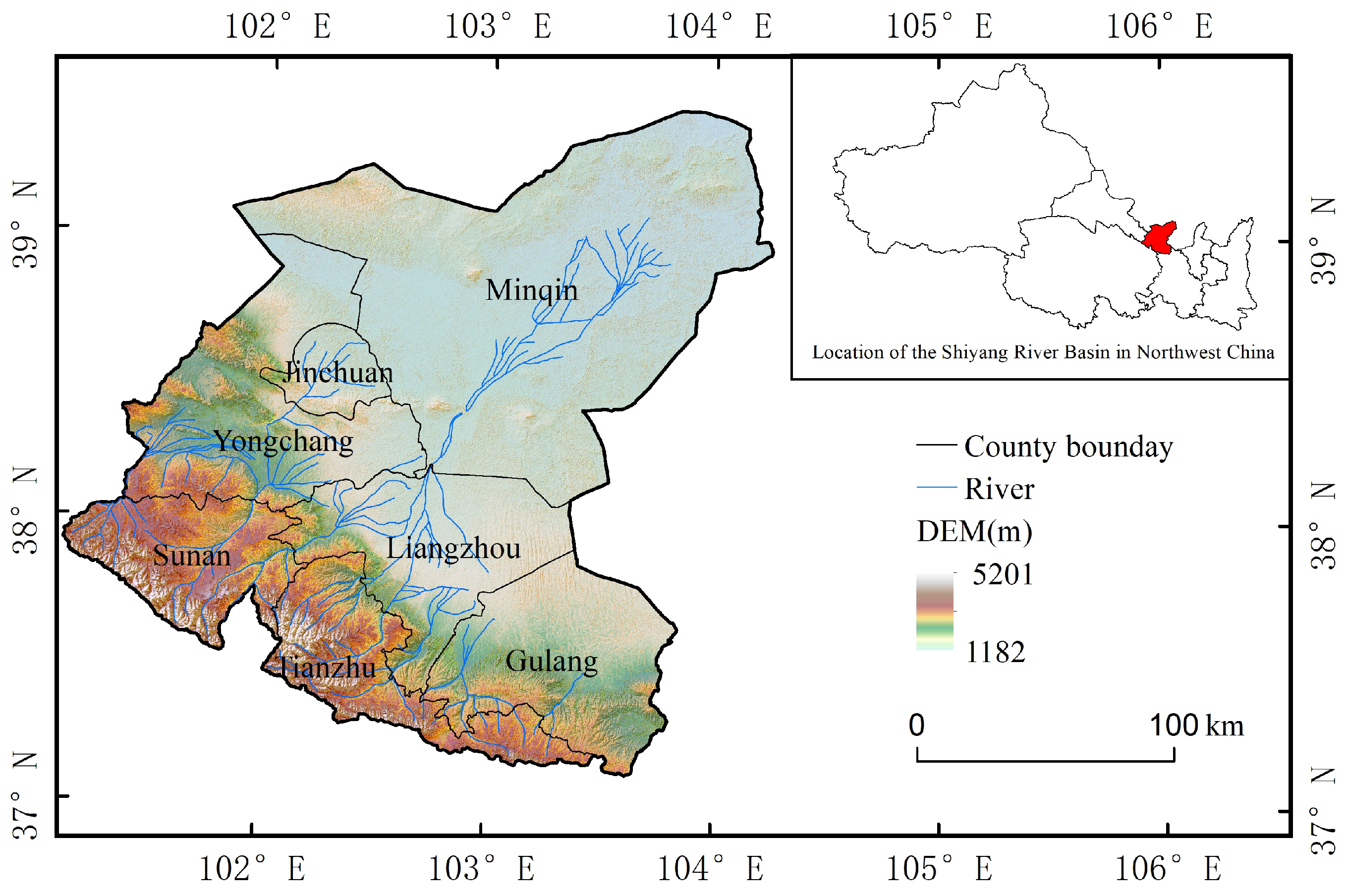
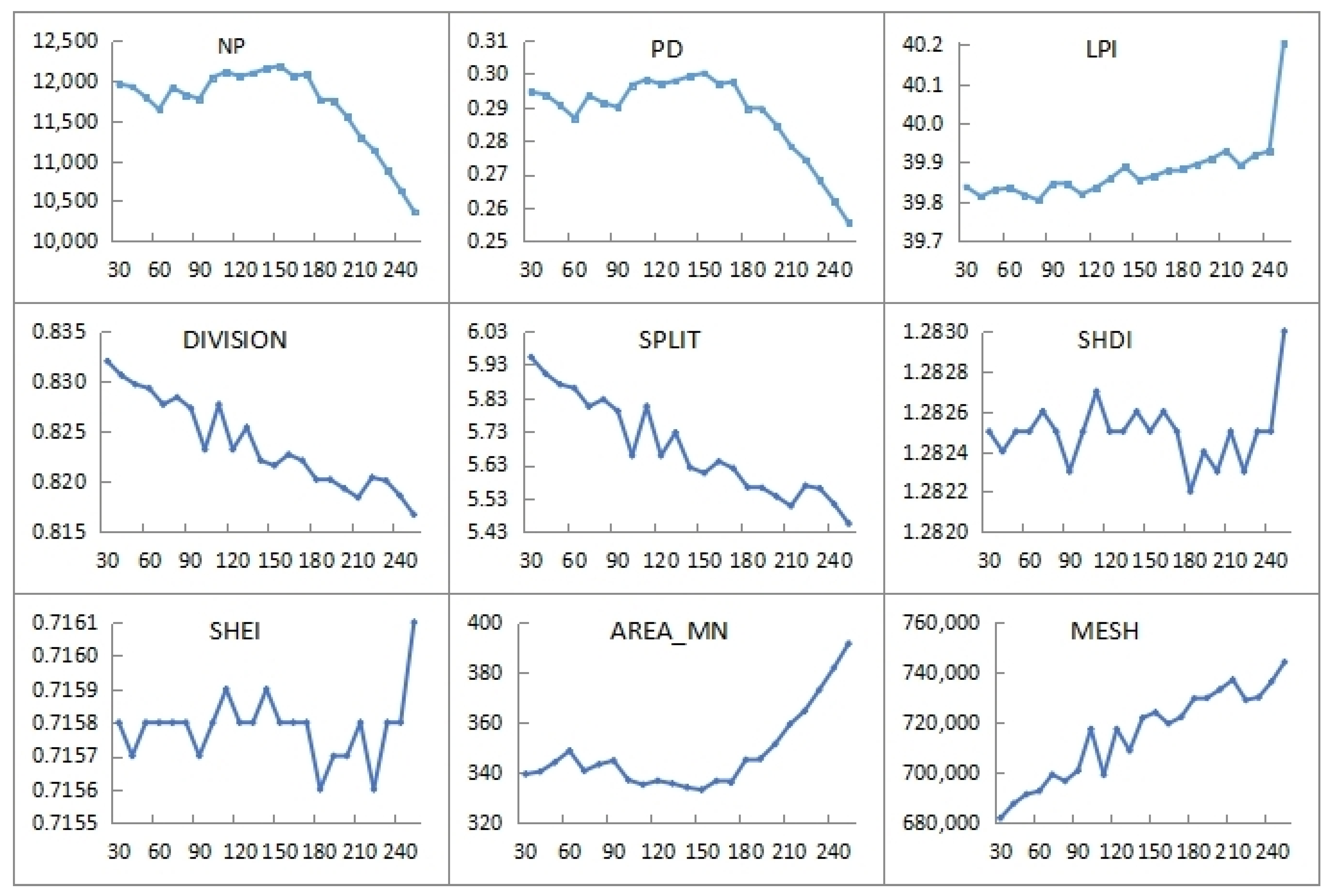
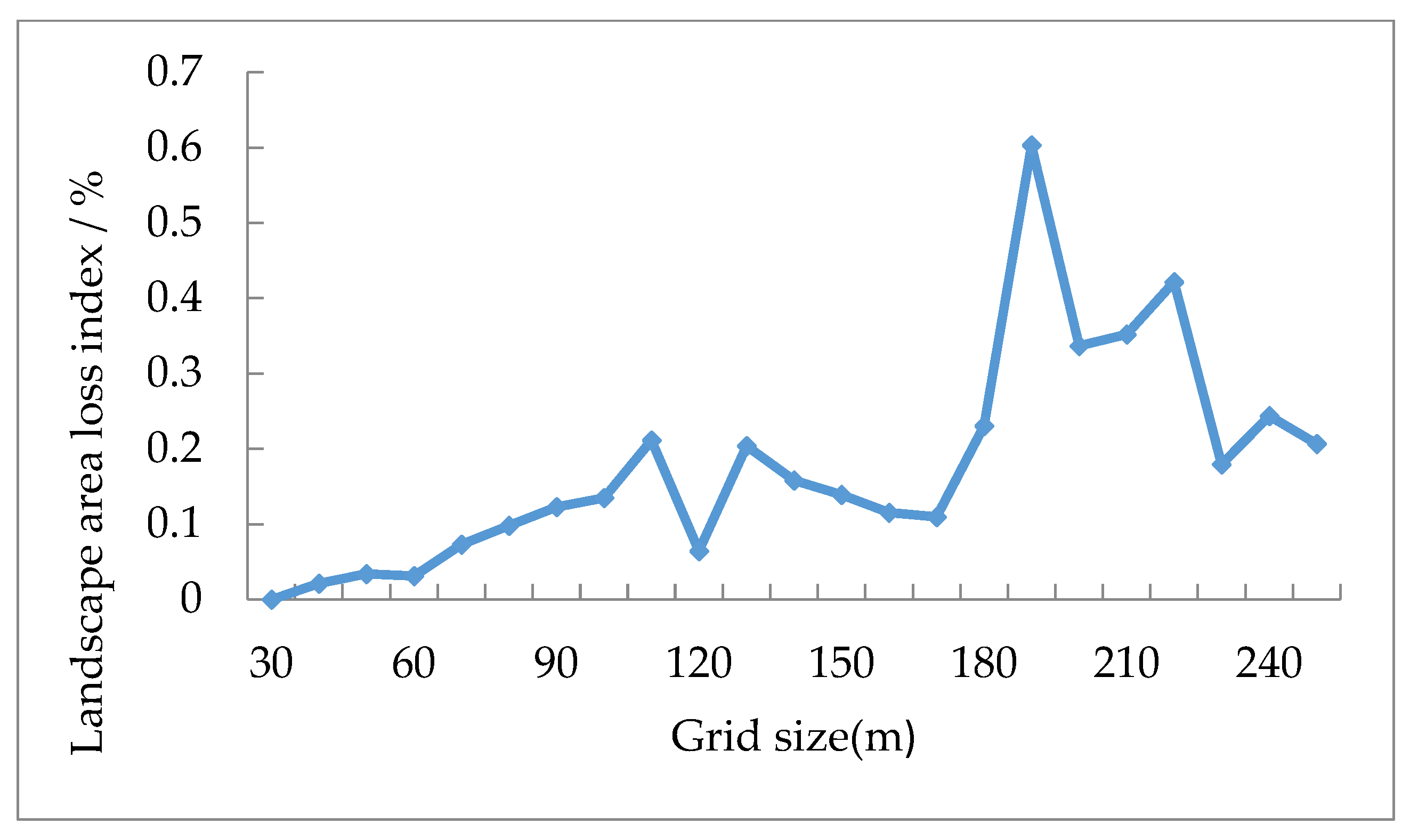

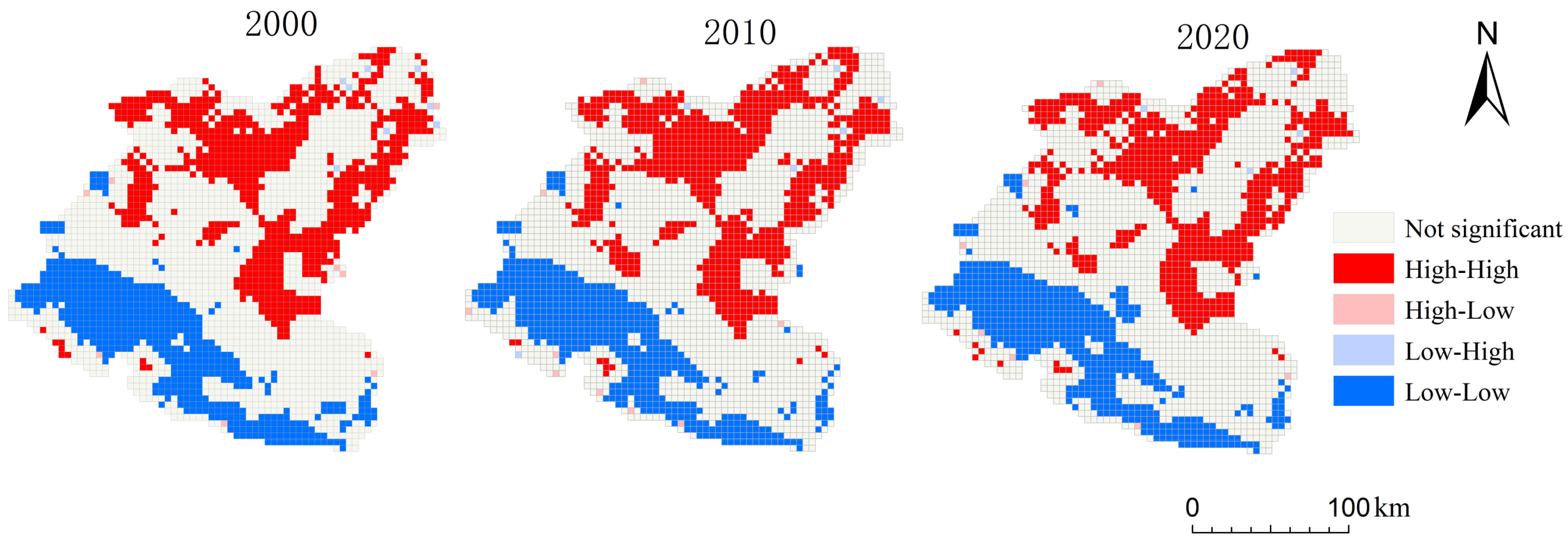
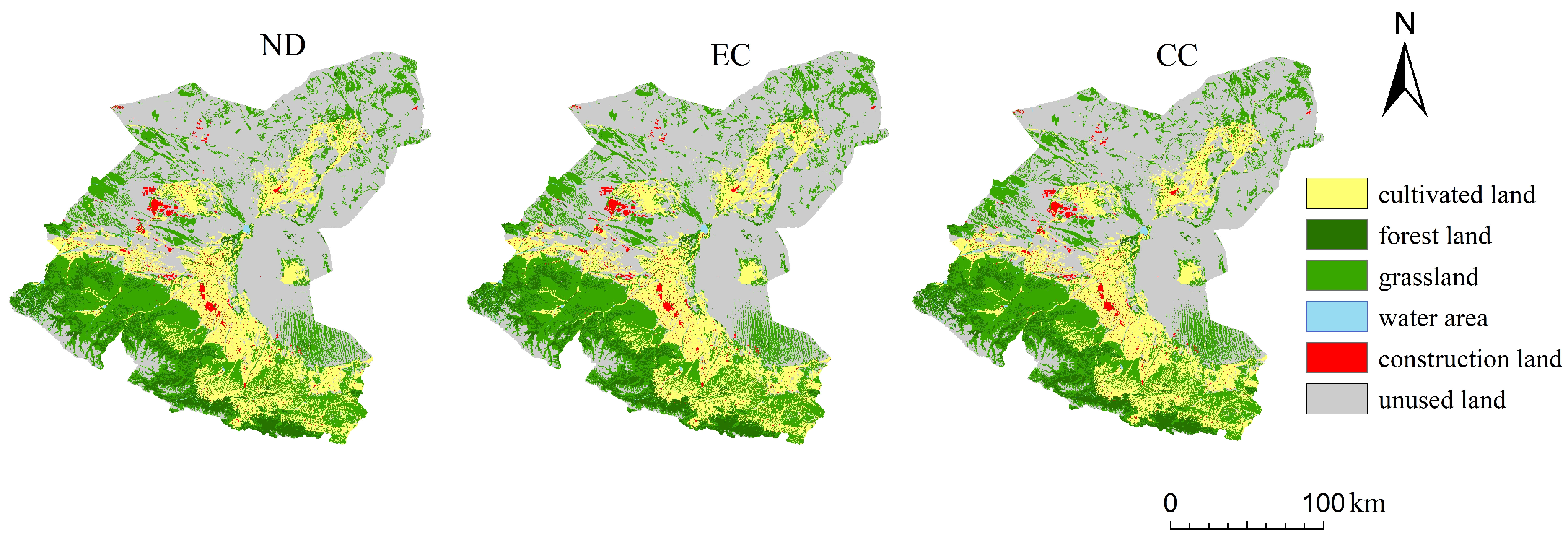
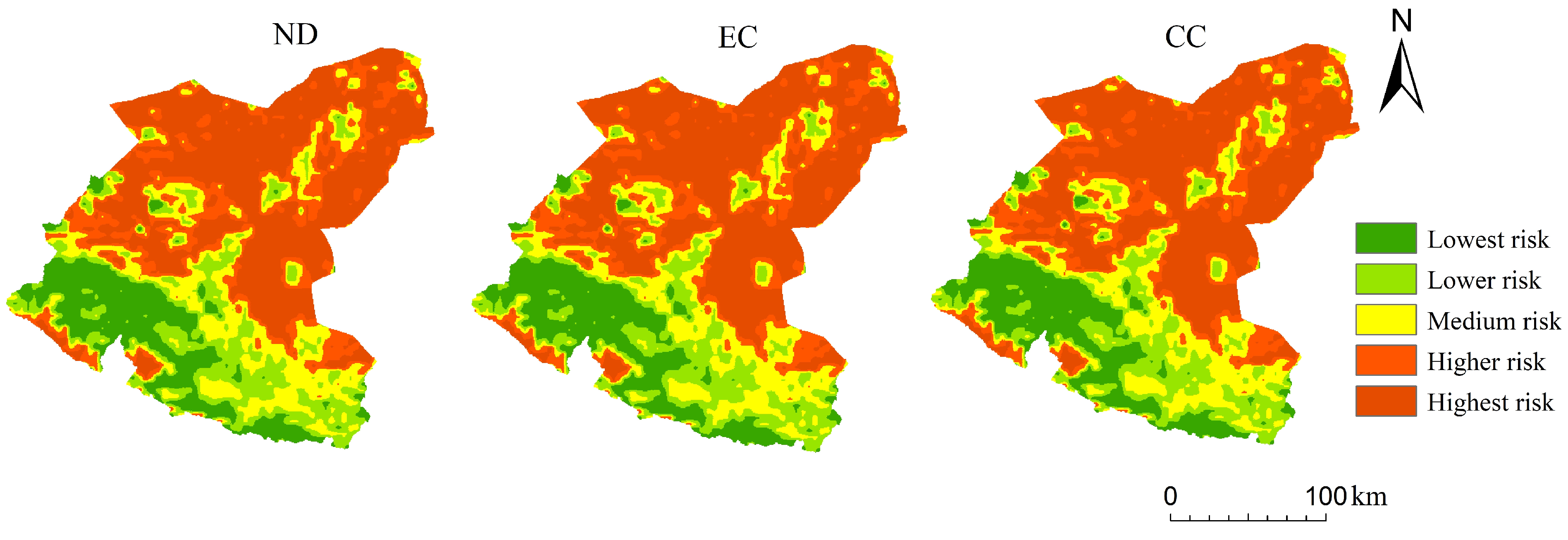

| Scale Size (km) | Best Model | Nugget | Still | Nugget/Still | Range (m) | RSS | R2 |
|---|---|---|---|---|---|---|---|
| 3 | Exponential | 3.8 × 10−5 | 2.05 × 10−4 | 0.1854 | 382,200 | 2.09 × 10−10 | 0.988 |
| 3.5 | Exponential | 3.6 × 10−5 | 1.99 × 10−4 | 0.1809 | 369,000 | 2.25 × 10−10 | 0.987 |
| 4 | Exponential | 3.4 × 10−5 | 1.87 × 10−4 | 0.1818 | 333,900 | 2.186 × 10−10 | 0.987 |
| 4.5 | Exponential | 3.2 × 10−5 | 1.99 × 10−4 | 0.1608 | 367,800 | 1.999 × 10−10 | 0.989 |
| 5 | Exponential | 2.9 × 10−5 | 1.98 × 10−4 | 0.1465 | 397,500 | 2.640 × 10−10 | 0.985 |
| Category | 2000 | 2010 | 2020 | |||
|---|---|---|---|---|---|---|
| Area (km2) | Proportion (%) | Area (km2) | Proportion (%) | Area (km2) | Proportion (%) | |
| Lowest risk | 5368.5 | 13.23 | 5608.5 | 13.82 | 5541.5 | 13.66 |
| Lower risk | 5677.25 | 13.99 | 5815.75 | 14.33 | 5893 | 14.52 |
| Medium risk | 6609.25 | 16.29 | 6866.5 | 16.92 | 6805.75 | 16.77 |
| Higher risk | 6962.75 | 17.16 | 6920.25 | 17.05 | 6908 | 17.02 |
| Highest risk | 15,961.75 | 39.33 | 15,368.5 | 37.87 | 15,431.25 | 38.03 |
| LER mean | 0.04762 | 0.04743 | 0.04731 | |||
| Category | 2020 (km2) | 2030 (km2) | Amount of Area Change (2020–2030) (km2) | ||||
|---|---|---|---|---|---|---|---|
| ND | EC | CC | ND | EC | CC | ||
| cultivated land | 7261.83 | 7293.76 | 7260.72 | 7359.10 | 31.93 | −1.11 | 97.27 |
| forest land | 2599.62 | 2567.07 | 2603.30 | 2512.85 | −32.55 | 3.68 | −86.77 |
| grassland | 11,004.85 | 11,084.19 | 11,102.16 | 11,073.43 | 79.34 | 97.30 | 68.58 |
| water area | 170.45 | 168.93 | 167.49 | 174.68 | −1.53 | −2.97 | 4.22 |
| construction land | 636.28 | 655.73 | 655.69 | 655.73 | 19.44 | 19.41 | 19.44 |
| unused land | 18,838.45 | 18,739.67 | 18,720.00 | 18,733.55 | −98.78 | −118.45 | −104.90 |
| Category | Status Quo (2020) | ND (2030) | EC (2030) | CC (2030) | ||||
|---|---|---|---|---|---|---|---|---|
| Area (km2) | Proportion (%) | Area (km2) | Proportion (%) | Area (km2) | Proportion (%) | Area (km2) | Proportion (%) | |
| Lowest risk | 5541.5 | 13.66 | 5613.75 | 13.83 | 5626.25 | 13.86 | 5608.5 | 13.82 |
| Lower risk | 5893 | 14.52 | 5896.5 | 14.53 | 5962.75 | 14.69 | 5815.75 | 14.33 |
| Medium risk | 6805.75 | 16.77 | 6810.25 | 16.78 | 6753.25 | 16.64 | 6866.5 | 16.92 |
| Higher risk | 6908 | 17.02 | 6911.75 | 17.03 | 6870 | 16.93 | 6920.25 | 17.05 |
| Highest risk | 15,431.25 | 38.03 | 15,347.25 | 37.82 | 15,367.25 | 37.87 | 15,368.5 | 37.87 |
| LER mean | 0.04731 | 0.04726 | 0.04725 | 0.04728 | ||||
Disclaimer/Publisher’s Note: The statements, opinions and data contained in all publications are solely those of the individual author(s) and contributor(s) and not of MDPI and/or the editor(s). MDPI and/or the editor(s) disclaim responsibility for any injury to people or property resulting from any ideas, methods, instructions or products referred to in the content. |
© 2023 by the authors. Licensee MDPI, Basel, Switzerland. This article is an open access article distributed under the terms and conditions of the Creative Commons Attribution (CC BY) license (https://creativecommons.org/licenses/by/4.0/).
Share and Cite
Xie, J.; Zhao, J.; Zhang, S.; Sun, Z. Optimal Scale and Scenario Simulation Analysis of Landscape Ecological Risk Assessment in the Shiyang River Basin. Sustainability 2023, 15, 15883. https://doi.org/10.3390/su152215883
Xie J, Zhao J, Zhang S, Sun Z. Optimal Scale and Scenario Simulation Analysis of Landscape Ecological Risk Assessment in the Shiyang River Basin. Sustainability. 2023; 15(22):15883. https://doi.org/10.3390/su152215883
Chicago/Turabian StyleXie, Jinfeng, Jun Zhao, Sheshu Zhang, and Ziyun Sun. 2023. "Optimal Scale and Scenario Simulation Analysis of Landscape Ecological Risk Assessment in the Shiyang River Basin" Sustainability 15, no. 22: 15883. https://doi.org/10.3390/su152215883




